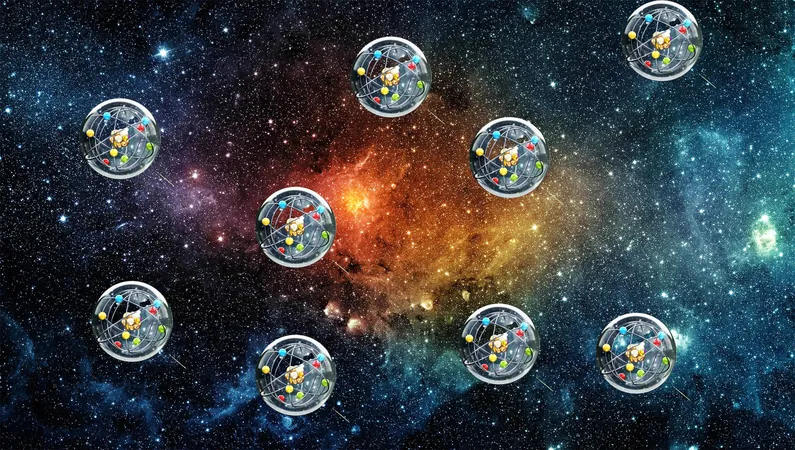
Are We Alone? Cosmic Discoveries Reveal Organic Molecules All Over the Universe!
2024-12-28
Author: Kai
Recent studies reveal that the universe is brimming with intricate, carbon-based compounds—organic molecules that could be the keys to understanding the emergence of life itself. Remarkably, many of these compounds are found in outer space, leading scientists to theorize that life's building blocks may have originated far beyond our planet.
Unraveling the Mysteries of Organic Molecules in Space
Astrophysicists and chemists have discovered a common theme while analyzing interstellar dust, comets, and asteroids: these celestial objects teem with a variety of organic molecules. The investigation began as early as 1986 with the European Giotto spacecraft, which made history by conducting in-situ analysis on comet 1P/Halley. The mission uncovered a surprising array of organic species, but the origins and formation processes of these compounds remained elusive.
Following this groundbreaking exploration, the Rosetta spacecraft made its mark in 2015 by both orbiting and landing on comet 67P. In a historic first, it detected glycine—an essential amino acid that acts as a fundamental building block of proteins—confirming the presence of organic molecules on a comet.
As of 2022, scientists digging through the vast data collected by Rosetta revealed an astonishing 44 different organic compounds in just a single day of exploration, some weighing up to 140 Daltons. Dr. Nora Hänni, a chemist at the University of Bern, noted that Rosetta’s findings shifted the scientific paradigm, especially when they identified dimethyl sulfide—typically produced by living organisms on Earth.
Asteroids: Cosmic Time Capsules
Japan’s Hayabusa2 and NASA’s OSIRIS-REx missions have also deepened our understanding of organics in space. The analysis of samples from asteroids Ryugu and Bennu revealed a treasure trove of at least 20,000 carbon-based compounds, including 15 different amino acids. “It’s everything possible from which life could emerge,” stated Philippe Schmitt-Kopplin from the Technical University of Munich.
These organic-rich samples provide an intriguing glimpse into a time before planets fully formed, raising questions about how these compounds originated: Did they form in the cold, dark dust clouds between stars, or did they emerge from energetic bursts near newborn stars? There’s a growing consensus among scientists that the early Earth may have been enriched by these extraterrestrial organic molecules.
The Chemistry of Life Across the Universe
Astronomers have traced polycyclic aromatic hydrocarbons (PAHs)—complex carbon structures—back to around 1.5 billion years after the Big Bang. PAHs typically form in dying stars, where carbon atoms create large, stable rings and chains through combustion-like processes. Astonishingly, observations reveal that more than 200 carbon compounds exist in interstellar space.
In the cold, dense molecular clouds, simple ingredients like methane form as atoms bind to cool dust grains. Ultraviolet radiation and cosmic rays then interact with these compounds, creating a host of new organic structures, potentially leading to life.
Future Exploration: What Lies Beneath Icy Surfaces?
Protoplanetary disks—the rotating clouds of gas and dust around young stars—show promise for harboring methanol and other organics that withstand the extreme conditions during stellar births. Scientists believe that cycling materials between hot and cold regions in these disks may lead to an even richer array of compounds that could explain the chemical abundance found in comets and asteroids.
When these organic-rich materials land on planets, they may kickstart the emergence of complex life forms. Some theories postulate that meteorites and comets delivered crucial amino acids and PAHs to the early Earth, setting the stage for life as we know it. However, the debate continues among astrobiologists regarding which molecules indicate life and which are false positives.
Looking Ahead: Are We Close to Discovering Extraterrestrial Life?
As we continue to uncover the mysteries surrounding organic molecules in space, future missions—including NASA's Europa Clipper and the European Space Agency’s Juice—aim to unveil what lies beneath icy surfaces of celestial bodies like Europa and Titan. Researchers hope to discover organic compounds that could provide profound insights into the potential for life beyond Earth and answer one of humanity's oldest questions: Are we alone in the universe?
Stay tuned for the latest updates on these mind-bending discoveries that could redefine our understanding of life itself!


 Brasil (PT)
Brasil (PT)
 Canada (EN)
Canada (EN)
 Chile (ES)
Chile (ES)
 Česko (CS)
Česko (CS)
 대한민국 (KO)
대한민국 (KO)
 España (ES)
España (ES)
 France (FR)
France (FR)
 Hong Kong (EN)
Hong Kong (EN)
 Italia (IT)
Italia (IT)
 日本 (JA)
日本 (JA)
 Magyarország (HU)
Magyarország (HU)
 Norge (NO)
Norge (NO)
 Polska (PL)
Polska (PL)
 Schweiz (DE)
Schweiz (DE)
 Singapore (EN)
Singapore (EN)
 Sverige (SV)
Sverige (SV)
 Suomi (FI)
Suomi (FI)
 Türkiye (TR)
Türkiye (TR)
 الإمارات العربية المتحدة (AR)
الإمارات العربية المتحدة (AR)